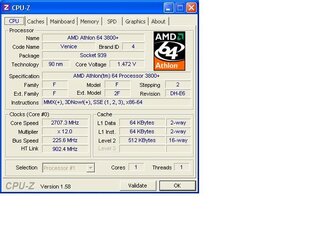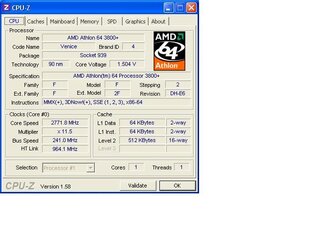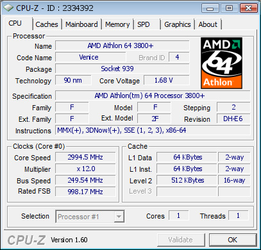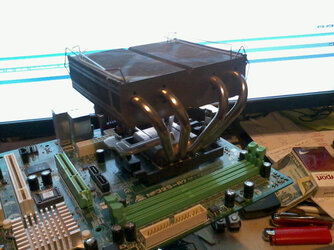- Joined
- Dec 14, 2010
Overclocking Escapades: socket 939 Athlon 64 3800+ Venice (E6)
When I started out to see what a socket 939 Athlon 64 3800+ Venice chip's limits were, I was encouraged, but then my hopes were quickly dashed.
I got it to do 2.6GHz on stock volts (1.4V), anything beyond that though required a massive voltage increase to 1.47-1.5V+. I hit a major wall at 2.7GHz and couldn't get stability past that, I got it up to 2.75-2.77GHz once or twice, but it wasn't very stable and upon reboot I couldn't get it to POST. Voltage increases had little to no effect, I went all the way to 1.55V and even upped the NB voltage, but it didn't help as I still couldn't get it stable past 2.7GHz.
Reducing the multiplier to 11.5x down from the stock 12x helped a little, as I could then get it to boot at 2.75GHz, but it locked up soon after entering the OS and would have likely required more voltage than my board could supply to remain stable.
Temps were good, at 2.7GHz I was idling in the high 30's/low 40's°C, and at load I still wasn't hitting 50°C.
I don't know if I've just got a stubborn CPU or a CPU that's a lemon when it comes to overclocking. I'd heard stories of folks achieving 2.7GHz+ on stock volts and was intrigued, my own results weren't nearly as impressive to me.


When I started out to see what a socket 939 Athlon 64 3800+ Venice chip's limits were, I was encouraged, but then my hopes were quickly dashed.
I got it to do 2.6GHz on stock volts (1.4V), anything beyond that though required a massive voltage increase to 1.47-1.5V+. I hit a major wall at 2.7GHz and couldn't get stability past that, I got it up to 2.75-2.77GHz once or twice, but it wasn't very stable and upon reboot I couldn't get it to POST. Voltage increases had little to no effect, I went all the way to 1.55V and even upped the NB voltage, but it didn't help as I still couldn't get it stable past 2.7GHz.
Reducing the multiplier to 11.5x down from the stock 12x helped a little, as I could then get it to boot at 2.75GHz, but it locked up soon after entering the OS and would have likely required more voltage than my board could supply to remain stable.
Temps were good, at 2.7GHz I was idling in the high 30's/low 40's°C, and at load I still wasn't hitting 50°C.
I don't know if I've just got a stubborn CPU or a CPU that's a lemon when it comes to overclocking. I'd heard stories of folks achieving 2.7GHz+ on stock volts and was intrigued, my own results weren't nearly as impressive to me.


Last edited:

